Case Study: Kobi Monterey - Nursing Assessment and Care Plan
VerifiedAdded on 2023/04/23
|13
|2741
|130
AI Summary
This document is a nursing assessment and care plan for Kobi Monterey, a patient suffering from respiratory distress due to sudden asthma attack. It includes normal and abnormal cues, related inferences, predicted outcomes, nursing problems, goals, and actions to achieve them. The document also discusses the clinical reasoning cycle and professional responsibility as a beginning level practitioner.
Contribute Materials
Your contribution can guide someone’s learning journey. Share your
documents today.
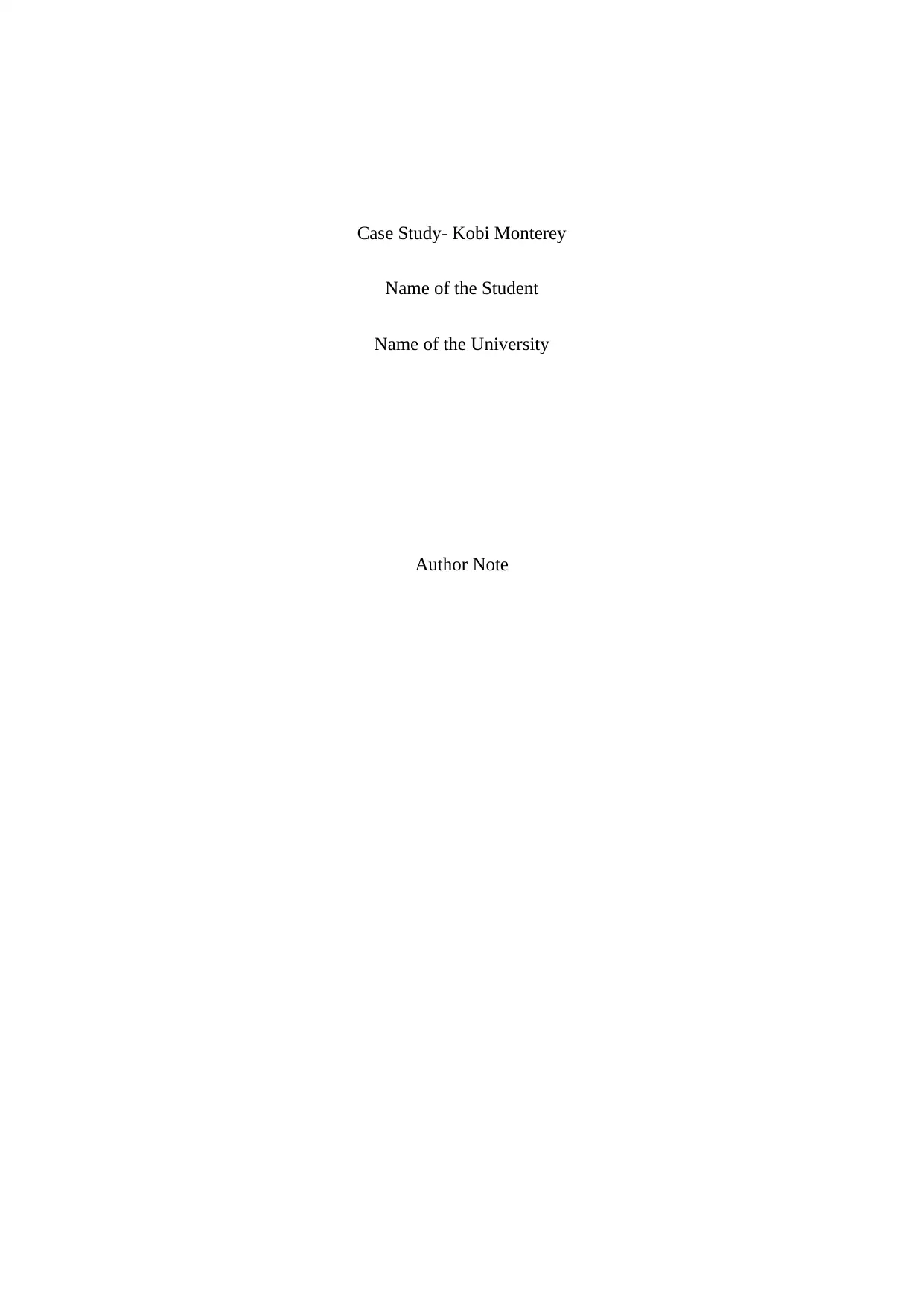
Case Study- Kobi Monterey
Name of the Student
Name of the University
Author Note
Name of the Student
Name of the University
Author Note
Secure Best Marks with AI Grader
Need help grading? Try our AI Grader for instant feedback on your assignments.
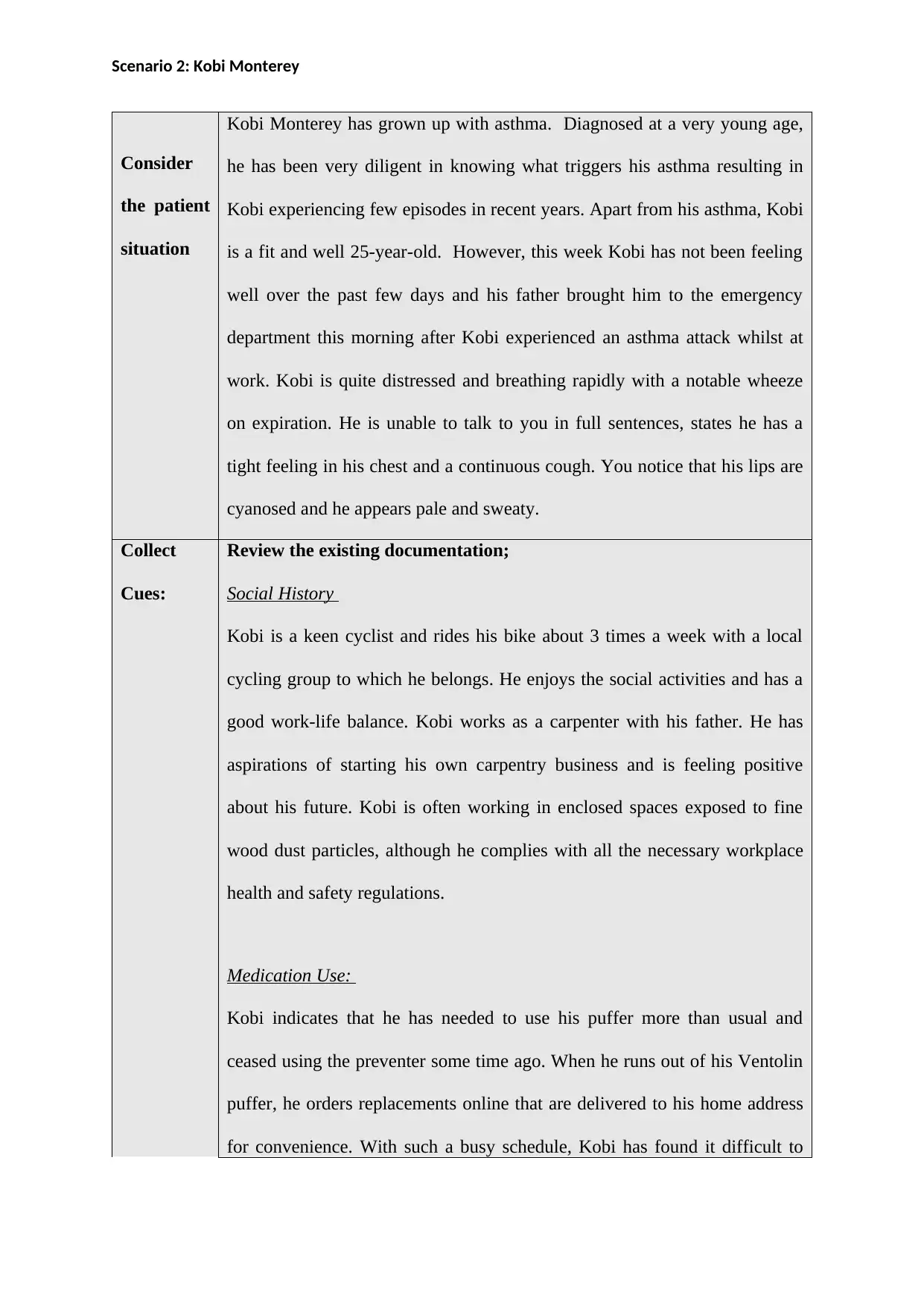
Scenario 2: Kobi Monterey
Consider
the patient
situation
Kobi Monterey has grown up with asthma. Diagnosed at a very young age,
he has been very diligent in knowing what triggers his asthma resulting in
Kobi experiencing few episodes in recent years. Apart from his asthma, Kobi
is a fit and well 25-year-old. However, this week Kobi has not been feeling
well over the past few days and his father brought him to the emergency
department this morning after Kobi experienced an asthma attack whilst at
work. Kobi is quite distressed and breathing rapidly with a notable wheeze
on expiration. He is unable to talk to you in full sentences, states he has a
tight feeling in his chest and a continuous cough. You notice that his lips are
cyanosed and he appears pale and sweaty.
Collect
Cues:
Review the existing documentation;
Social History
Kobi is a keen cyclist and rides his bike about 3 times a week with a local
cycling group to which he belongs. He enjoys the social activities and has a
good work-life balance. Kobi works as a carpenter with his father. He has
aspirations of starting his own carpentry business and is feeling positive
about his future. Kobi is often working in enclosed spaces exposed to fine
wood dust particles, although he complies with all the necessary workplace
health and safety regulations.
Medication Use:
Kobi indicates that he has needed to use his puffer more than usual and
ceased using the preventer some time ago. When he runs out of his Ventolin
puffer, he orders replacements online that are delivered to his home address
for convenience. With such a busy schedule, Kobi has found it difficult to
Consider
the patient
situation
Kobi Monterey has grown up with asthma. Diagnosed at a very young age,
he has been very diligent in knowing what triggers his asthma resulting in
Kobi experiencing few episodes in recent years. Apart from his asthma, Kobi
is a fit and well 25-year-old. However, this week Kobi has not been feeling
well over the past few days and his father brought him to the emergency
department this morning after Kobi experienced an asthma attack whilst at
work. Kobi is quite distressed and breathing rapidly with a notable wheeze
on expiration. He is unable to talk to you in full sentences, states he has a
tight feeling in his chest and a continuous cough. You notice that his lips are
cyanosed and he appears pale and sweaty.
Collect
Cues:
Review the existing documentation;
Social History
Kobi is a keen cyclist and rides his bike about 3 times a week with a local
cycling group to which he belongs. He enjoys the social activities and has a
good work-life balance. Kobi works as a carpenter with his father. He has
aspirations of starting his own carpentry business and is feeling positive
about his future. Kobi is often working in enclosed spaces exposed to fine
wood dust particles, although he complies with all the necessary workplace
health and safety regulations.
Medication Use:
Kobi indicates that he has needed to use his puffer more than usual and
ceased using the preventer some time ago. When he runs out of his Ventolin
puffer, he orders replacements online that are delivered to his home address
for convenience. With such a busy schedule, Kobi has found it difficult to
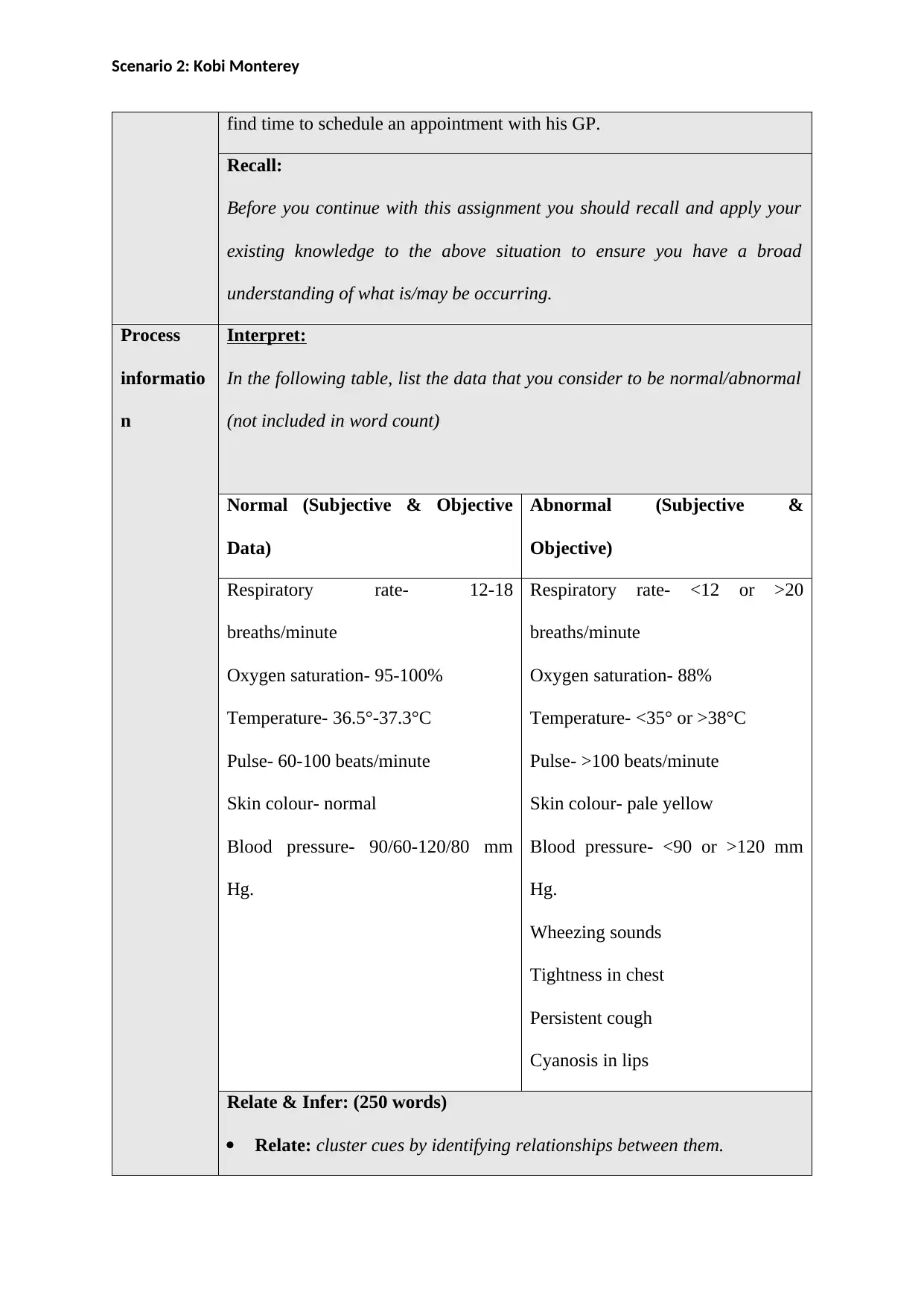
Scenario 2: Kobi Monterey
find time to schedule an appointment with his GP.
Recall:
Before you continue with this assignment you should recall and apply your
existing knowledge to the above situation to ensure you have a broad
understanding of what is/may be occurring.
Process
informatio
n
Interpret:
In the following table, list the data that you consider to be normal/abnormal
(not included in word count)
Normal (Subjective & Objective
Data)
Abnormal (Subjective &
Objective)
Respiratory rate- 12-18
breaths/minute
Oxygen saturation- 95-100%
Temperature- 36.5°-37.3°C
Pulse- 60-100 beats/minute
Skin colour- normal
Blood pressure- 90/60-120/80 mm
Hg.
Respiratory rate- <12 or >20
breaths/minute
Oxygen saturation- 88%
Temperature- <35° or >38°C
Pulse- >100 beats/minute
Skin colour- pale yellow
Blood pressure- <90 or >120 mm
Hg.
Wheezing sounds
Tightness in chest
Persistent cough
Cyanosis in lips
Relate & Infer: (250 words)
Relate: cluster cues by identifying relationships between them.
find time to schedule an appointment with his GP.
Recall:
Before you continue with this assignment you should recall and apply your
existing knowledge to the above situation to ensure you have a broad
understanding of what is/may be occurring.
Process
informatio
n
Interpret:
In the following table, list the data that you consider to be normal/abnormal
(not included in word count)
Normal (Subjective & Objective
Data)
Abnormal (Subjective &
Objective)
Respiratory rate- 12-18
breaths/minute
Oxygen saturation- 95-100%
Temperature- 36.5°-37.3°C
Pulse- 60-100 beats/minute
Skin colour- normal
Blood pressure- 90/60-120/80 mm
Hg.
Respiratory rate- <12 or >20
breaths/minute
Oxygen saturation- 88%
Temperature- <35° or >38°C
Pulse- >100 beats/minute
Skin colour- pale yellow
Blood pressure- <90 or >120 mm
Hg.
Wheezing sounds
Tightness in chest
Persistent cough
Cyanosis in lips
Relate & Infer: (250 words)
Relate: cluster cues by identifying relationships between them.
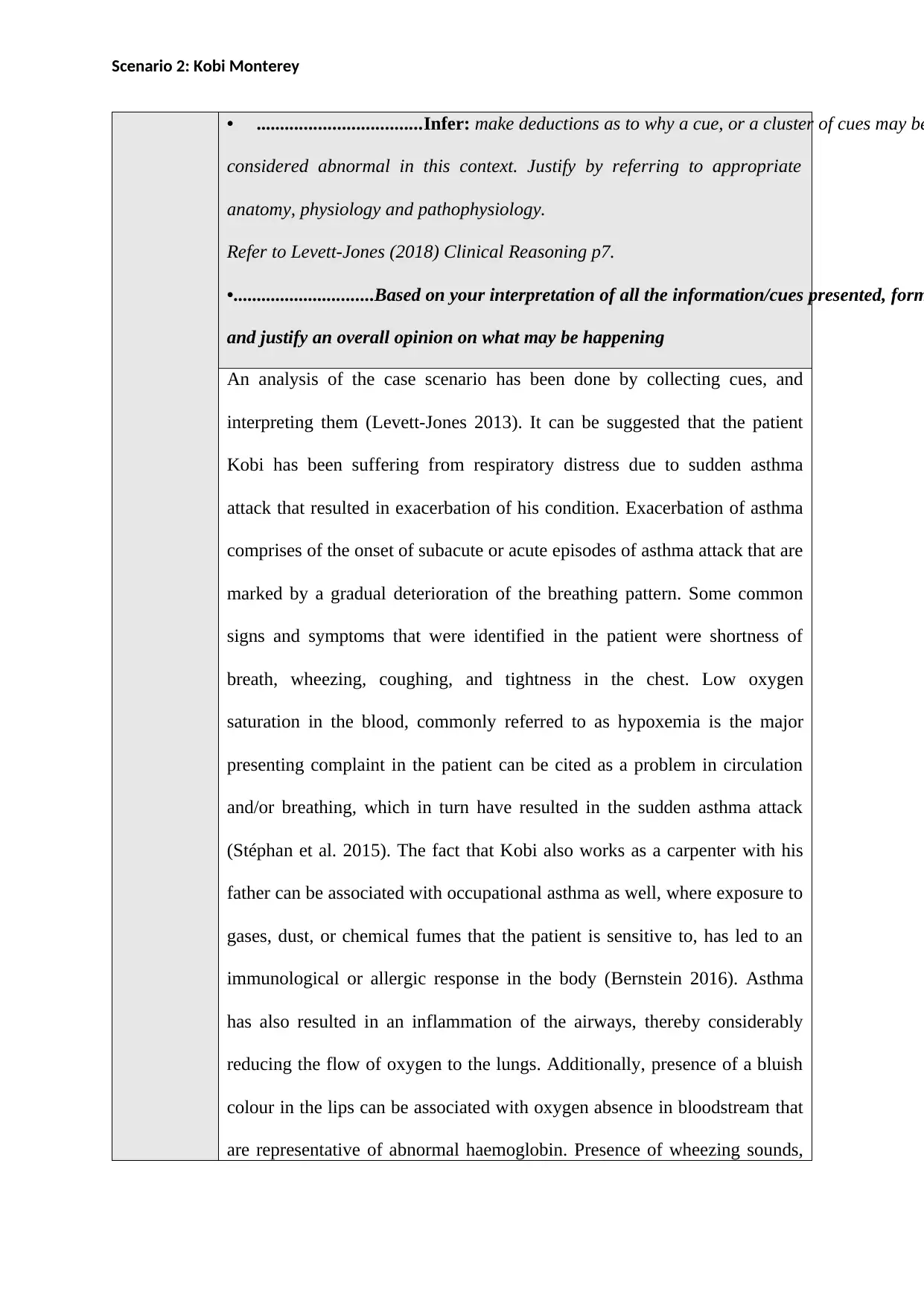
Scenario 2: Kobi Monterey
• ...................................Infer: make deductions as to why a cue, or a cluster of cues may be
considered abnormal in this context. Justify by referring to appropriate
anatomy, physiology and pathophysiology.
Refer to Levett-Jones (2018) Clinical Reasoning p7.
•..............................Based on your interpretation of all the information/cues presented, form
and justify an overall opinion on what may be happening
An analysis of the case scenario has been done by collecting cues, and
interpreting them (Levett-Jones 2013). It can be suggested that the patient
Kobi has been suffering from respiratory distress due to sudden asthma
attack that resulted in exacerbation of his condition. Exacerbation of asthma
comprises of the onset of subacute or acute episodes of asthma attack that are
marked by a gradual deterioration of the breathing pattern. Some common
signs and symptoms that were identified in the patient were shortness of
breath, wheezing, coughing, and tightness in the chest. Low oxygen
saturation in the blood, commonly referred to as hypoxemia is the major
presenting complaint in the patient can be cited as a problem in circulation
and/or breathing, which in turn have resulted in the sudden asthma attack
(Stéphan et al. 2015). The fact that Kobi also works as a carpenter with his
father can be associated with occupational asthma as well, where exposure to
gases, dust, or chemical fumes that the patient is sensitive to, has led to an
immunological or allergic response in the body (Bernstein 2016). Asthma
has also resulted in an inflammation of the airways, thereby considerably
reducing the flow of oxygen to the lungs. Additionally, presence of a bluish
colour in the lips can be associated with oxygen absence in bloodstream that
are representative of abnormal haemoglobin. Presence of wheezing sounds,
• ...................................Infer: make deductions as to why a cue, or a cluster of cues may be
considered abnormal in this context. Justify by referring to appropriate
anatomy, physiology and pathophysiology.
Refer to Levett-Jones (2018) Clinical Reasoning p7.
•..............................Based on your interpretation of all the information/cues presented, form
and justify an overall opinion on what may be happening
An analysis of the case scenario has been done by collecting cues, and
interpreting them (Levett-Jones 2013). It can be suggested that the patient
Kobi has been suffering from respiratory distress due to sudden asthma
attack that resulted in exacerbation of his condition. Exacerbation of asthma
comprises of the onset of subacute or acute episodes of asthma attack that are
marked by a gradual deterioration of the breathing pattern. Some common
signs and symptoms that were identified in the patient were shortness of
breath, wheezing, coughing, and tightness in the chest. Low oxygen
saturation in the blood, commonly referred to as hypoxemia is the major
presenting complaint in the patient can be cited as a problem in circulation
and/or breathing, which in turn have resulted in the sudden asthma attack
(Stéphan et al. 2015). The fact that Kobi also works as a carpenter with his
father can be associated with occupational asthma as well, where exposure to
gases, dust, or chemical fumes that the patient is sensitive to, has led to an
immunological or allergic response in the body (Bernstein 2016). Asthma
has also resulted in an inflammation of the airways, thereby considerably
reducing the flow of oxygen to the lungs. Additionally, presence of a bluish
colour in the lips can be associated with oxygen absence in bloodstream that
are representative of abnormal haemoglobin. Presence of wheezing sounds,
Secure Best Marks with AI Grader
Need help grading? Try our AI Grader for instant feedback on your assignments.
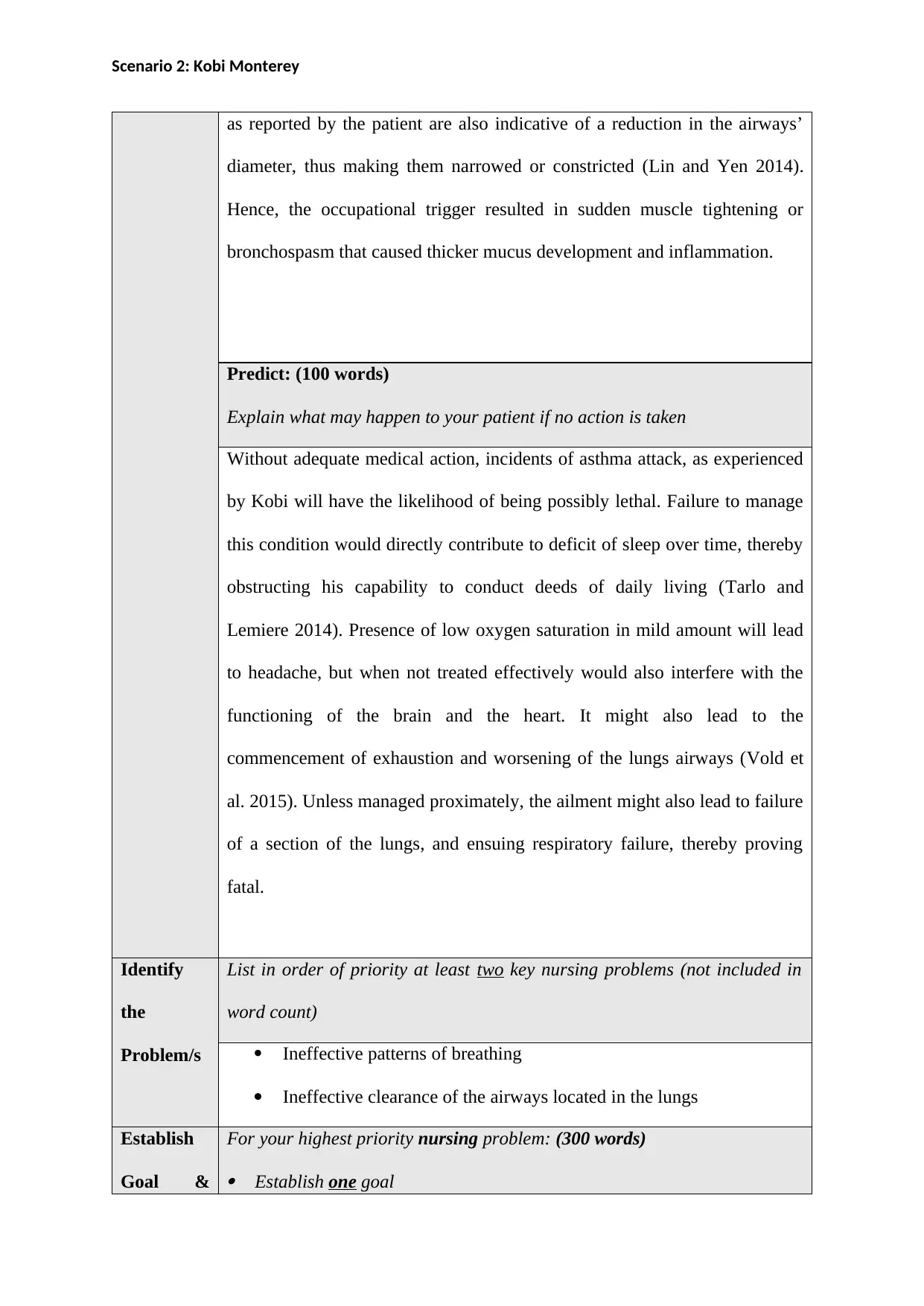
Scenario 2: Kobi Monterey
as reported by the patient are also indicative of a reduction in the airways’
diameter, thus making them narrowed or constricted (Lin and Yen 2014).
Hence, the occupational trigger resulted in sudden muscle tightening or
bronchospasm that caused thicker mucus development and inflammation.
Predict: (100 words)
Explain what may happen to your patient if no action is taken
Without adequate medical action, incidents of asthma attack, as experienced
by Kobi will have the likelihood of being possibly lethal. Failure to manage
this condition would directly contribute to deficit of sleep over time, thereby
obstructing his capability to conduct deeds of daily living (Tarlo and
Lemiere 2014). Presence of low oxygen saturation in mild amount will lead
to headache, but when not treated effectively would also interfere with the
functioning of the brain and the heart. It might also lead to the
commencement of exhaustion and worsening of the lungs airways (Vold et
al. 2015). Unless managed proximately, the ailment might also lead to failure
of a section of the lungs, and ensuing respiratory failure, thereby proving
fatal.
Identify
the
Problem/s
List in order of priority at least two key nursing problems (not included in
word count)
Ineffective patterns of breathing
Ineffective clearance of the airways located in the lungs
Establish
Goal &
For your highest priority nursing problem: (300 words)
Establish one goal
as reported by the patient are also indicative of a reduction in the airways’
diameter, thus making them narrowed or constricted (Lin and Yen 2014).
Hence, the occupational trigger resulted in sudden muscle tightening or
bronchospasm that caused thicker mucus development and inflammation.
Predict: (100 words)
Explain what may happen to your patient if no action is taken
Without adequate medical action, incidents of asthma attack, as experienced
by Kobi will have the likelihood of being possibly lethal. Failure to manage
this condition would directly contribute to deficit of sleep over time, thereby
obstructing his capability to conduct deeds of daily living (Tarlo and
Lemiere 2014). Presence of low oxygen saturation in mild amount will lead
to headache, but when not treated effectively would also interfere with the
functioning of the brain and the heart. It might also lead to the
commencement of exhaustion and worsening of the lungs airways (Vold et
al. 2015). Unless managed proximately, the ailment might also lead to failure
of a section of the lungs, and ensuing respiratory failure, thereby proving
fatal.
Identify
the
Problem/s
List in order of priority at least two key nursing problems (not included in
word count)
Ineffective patterns of breathing
Ineffective clearance of the airways located in the lungs
Establish
Goal &
For your highest priority nursing problem: (300 words)
Establish one goal
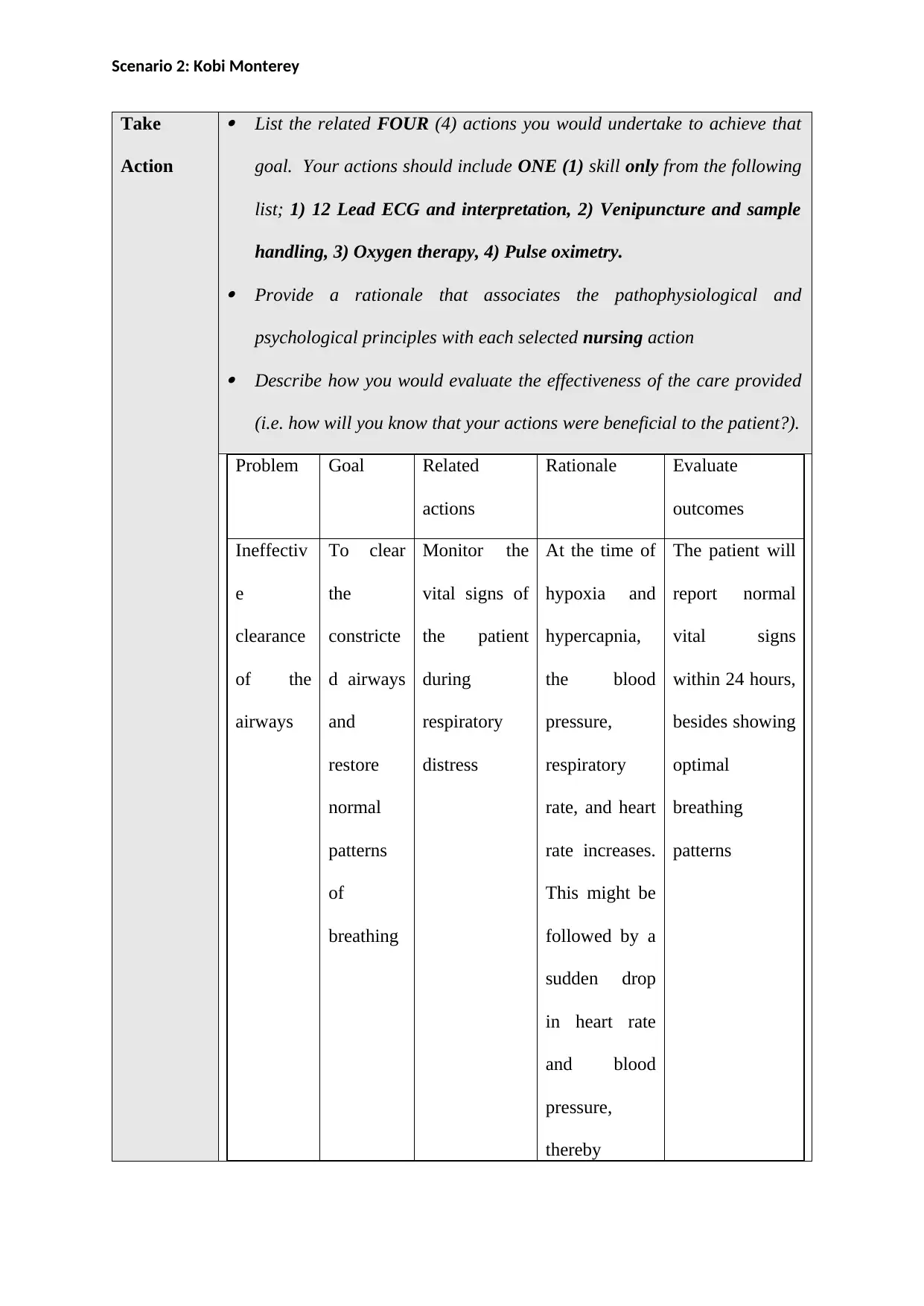
Scenario 2: Kobi Monterey
Take
Action
List the related FOUR (4) actions you would undertake to achieve that
goal. Your actions should include ONE (1) skill only from the following
list; 1) 12 Lead ECG and interpretation, 2) Venipuncture and sample
handling, 3) Oxygen therapy, 4) Pulse oximetry.
Provide a rationale that associates the pathophysiological and
psychological principles with each selected nursing action
Describe how you would evaluate the effectiveness of the care provided
(i.e. how will you know that your actions were beneficial to the patient?).
Problem Goal Related
actions
Rationale Evaluate
outcomes
Ineffectiv
e
clearance
of the
airways
To clear
the
constricte
d airways
and
restore
normal
patterns
of
breathing
Monitor the
vital signs of
the patient
during
respiratory
distress
At the time of
hypoxia and
hypercapnia,
the blood
pressure,
respiratory
rate, and heart
rate increases.
This might be
followed by a
sudden drop
in heart rate
and blood
pressure,
thereby
The patient will
report normal
vital signs
within 24 hours,
besides showing
optimal
breathing
patterns
Take
Action
List the related FOUR (4) actions you would undertake to achieve that
goal. Your actions should include ONE (1) skill only from the following
list; 1) 12 Lead ECG and interpretation, 2) Venipuncture and sample
handling, 3) Oxygen therapy, 4) Pulse oximetry.
Provide a rationale that associates the pathophysiological and
psychological principles with each selected nursing action
Describe how you would evaluate the effectiveness of the care provided
(i.e. how will you know that your actions were beneficial to the patient?).
Problem Goal Related
actions
Rationale Evaluate
outcomes
Ineffectiv
e
clearance
of the
airways
To clear
the
constricte
d airways
and
restore
normal
patterns
of
breathing
Monitor the
vital signs of
the patient
during
respiratory
distress
At the time of
hypoxia and
hypercapnia,
the blood
pressure,
respiratory
rate, and heart
rate increases.
This might be
followed by a
sudden drop
in heart rate
and blood
pressure,
thereby
The patient will
report normal
vital signs
within 24 hours,
besides showing
optimal
breathing
patterns
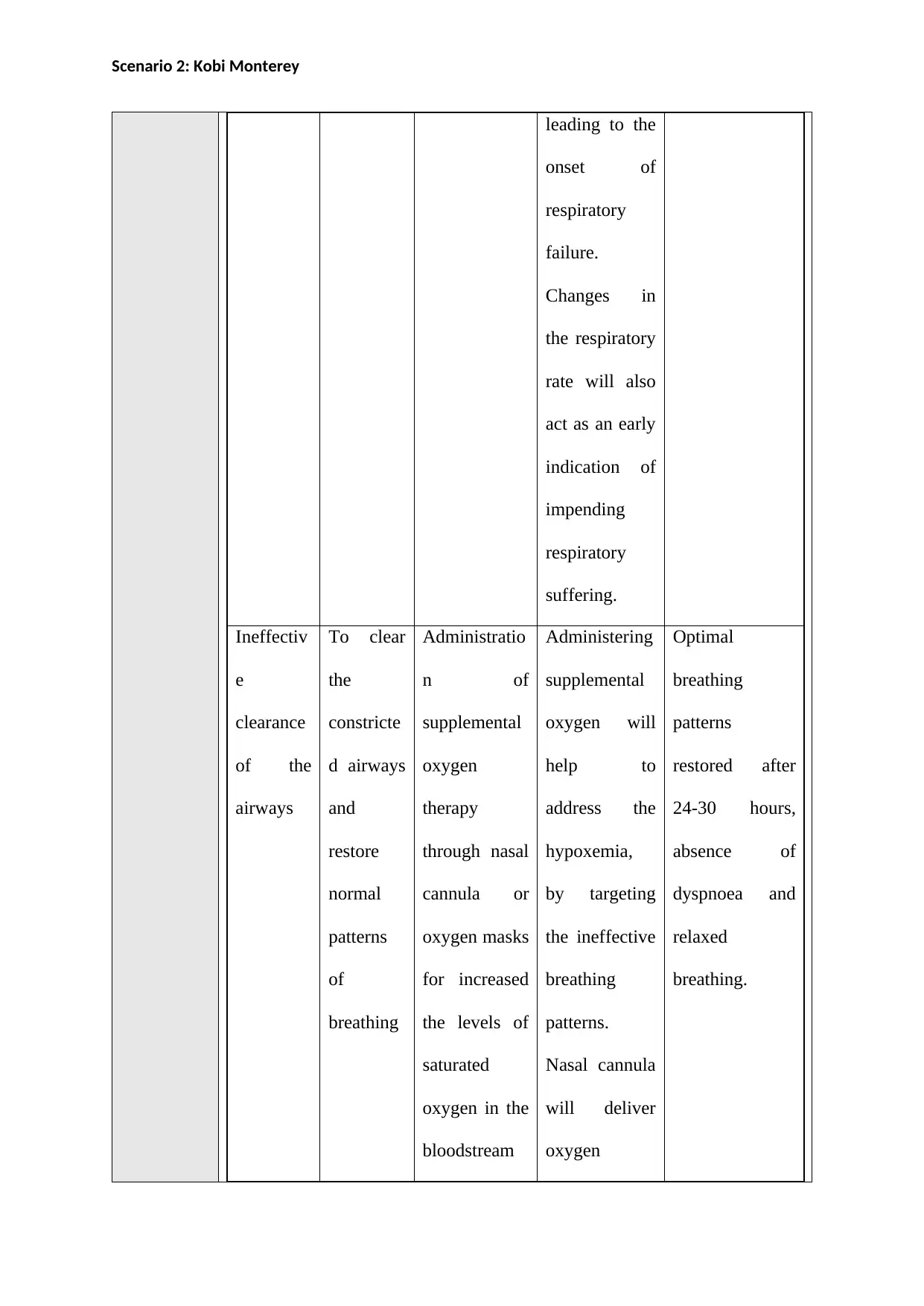
Scenario 2: Kobi Monterey
leading to the
onset of
respiratory
failure.
Changes in
the respiratory
rate will also
act as an early
indication of
impending
respiratory
suffering.
Ineffectiv
e
clearance
of the
airways
To clear
the
constricte
d airways
and
restore
normal
patterns
of
breathing
Administratio
n of
supplemental
oxygen
therapy
through nasal
cannula or
oxygen masks
for increased
the levels of
saturated
oxygen in the
bloodstream
Administering
supplemental
oxygen will
help to
address the
hypoxemia,
by targeting
the ineffective
breathing
patterns.
Nasal cannula
will deliver
oxygen
Optimal
breathing
patterns
restored after
24-30 hours,
absence of
dyspnoea and
relaxed
breathing.
leading to the
onset of
respiratory
failure.
Changes in
the respiratory
rate will also
act as an early
indication of
impending
respiratory
suffering.
Ineffectiv
e
clearance
of the
airways
To clear
the
constricte
d airways
and
restore
normal
patterns
of
breathing
Administratio
n of
supplemental
oxygen
therapy
through nasal
cannula or
oxygen masks
for increased
the levels of
saturated
oxygen in the
bloodstream
Administering
supplemental
oxygen will
help to
address the
hypoxemia,
by targeting
the ineffective
breathing
patterns.
Nasal cannula
will deliver
oxygen
Optimal
breathing
patterns
restored after
24-30 hours,
absence of
dyspnoea and
relaxed
breathing.
Paraphrase This Document
Need a fresh take? Get an instant paraphrase of this document with our AI Paraphraser
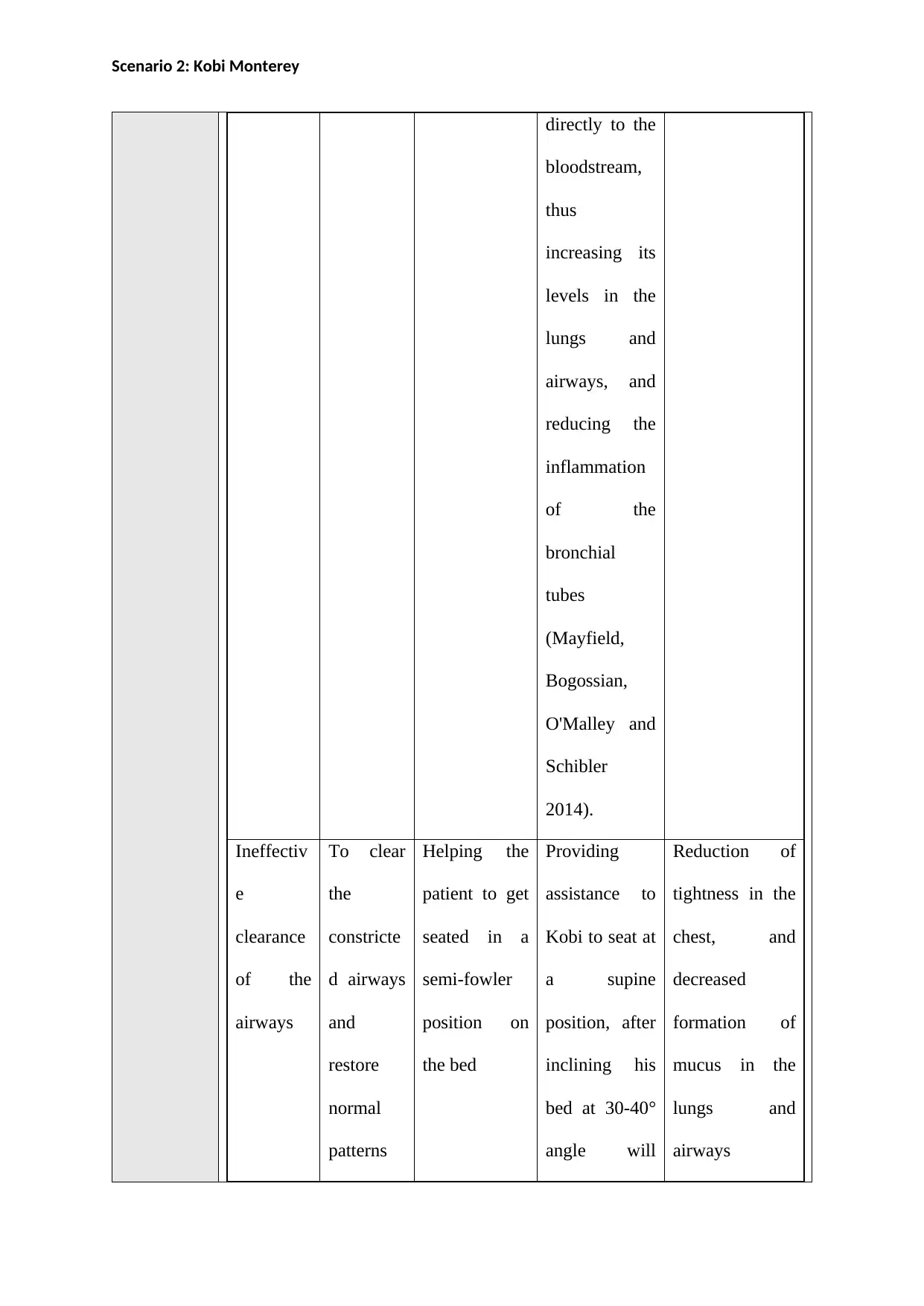
Scenario 2: Kobi Monterey
directly to the
bloodstream,
thus
increasing its
levels in the
lungs and
airways, and
reducing the
inflammation
of the
bronchial
tubes
(Mayfield,
Bogossian,
O'Malley and
Schibler
2014).
Ineffectiv
e
clearance
of the
airways
To clear
the
constricte
d airways
and
restore
normal
patterns
Helping the
patient to get
seated in a
semi-fowler
position on
the bed
Providing
assistance to
Kobi to seat at
a supine
position, after
inclining his
bed at 30-40°
angle will
Reduction of
tightness in the
chest, and
decreased
formation of
mucus in the
lungs and
airways
directly to the
bloodstream,
thus
increasing its
levels in the
lungs and
airways, and
reducing the
inflammation
of the
bronchial
tubes
(Mayfield,
Bogossian,
O'Malley and
Schibler
2014).
Ineffectiv
e
clearance
of the
airways
To clear
the
constricte
d airways
and
restore
normal
patterns
Helping the
patient to get
seated in a
semi-fowler
position on
the bed
Providing
assistance to
Kobi to seat at
a supine
position, after
inclining his
bed at 30-40°
angle will
Reduction of
tightness in the
chest, and
decreased
formation of
mucus in the
lungs and
airways
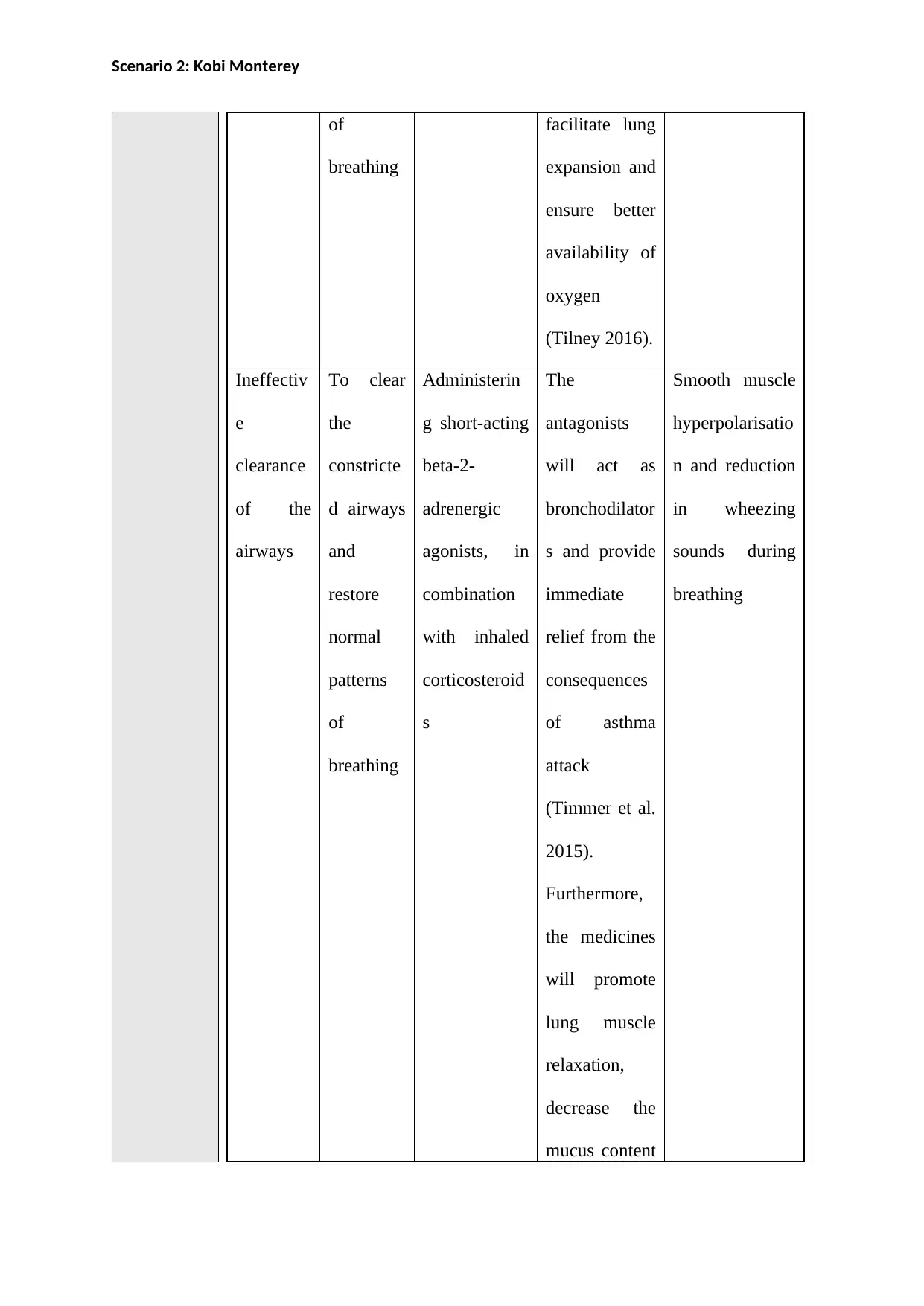
Scenario 2: Kobi Monterey
of
breathing
facilitate lung
expansion and
ensure better
availability of
oxygen
(Tilney 2016).
Ineffectiv
e
clearance
of the
airways
To clear
the
constricte
d airways
and
restore
normal
patterns
of
breathing
Administerin
g short-acting
beta-2-
adrenergic
agonists, in
combination
with inhaled
corticosteroid
s
The
antagonists
will act as
bronchodilator
s and provide
immediate
relief from the
consequences
of asthma
attack
(Timmer et al.
2015).
Furthermore,
the medicines
will promote
lung muscle
relaxation,
decrease the
mucus content
Smooth muscle
hyperpolarisatio
n and reduction
in wheezing
sounds during
breathing
of
breathing
facilitate lung
expansion and
ensure better
availability of
oxygen
(Tilney 2016).
Ineffectiv
e
clearance
of the
airways
To clear
the
constricte
d airways
and
restore
normal
patterns
of
breathing
Administerin
g short-acting
beta-2-
adrenergic
agonists, in
combination
with inhaled
corticosteroid
s
The
antagonists
will act as
bronchodilator
s and provide
immediate
relief from the
consequences
of asthma
attack
(Timmer et al.
2015).
Furthermore,
the medicines
will promote
lung muscle
relaxation,
decrease the
mucus content
Smooth muscle
hyperpolarisatio
n and reduction
in wheezing
sounds during
breathing
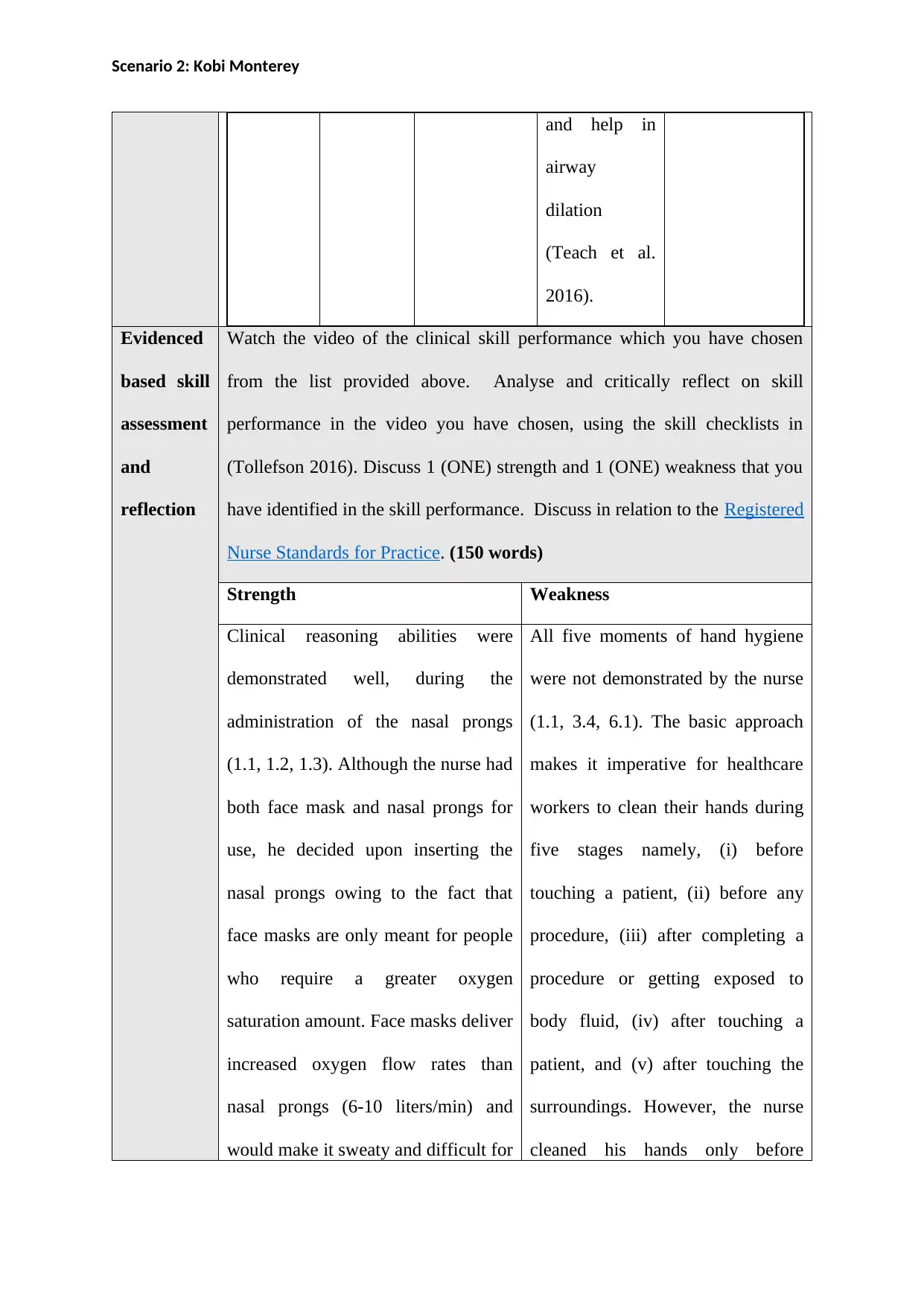
Scenario 2: Kobi Monterey
and help in
airway
dilation
(Teach et al.
2016).
Evidenced
based skill
assessment
and
reflection
Watch the video of the clinical skill performance which you have chosen
from the list provided above. Analyse and critically reflect on skill
performance in the video you have chosen, using the skill checklists in
(Tollefson 2016). Discuss 1 (ONE) strength and 1 (ONE) weakness that you
have identified in the skill performance. Discuss in relation to the Registered
Nurse Standards for Practice. (150 words)
Strength Weakness
Clinical reasoning abilities were
demonstrated well, during the
administration of the nasal prongs
(1.1, 1.2, 1.3). Although the nurse had
both face mask and nasal prongs for
use, he decided upon inserting the
nasal prongs owing to the fact that
face masks are only meant for people
who require a greater oxygen
saturation amount. Face masks deliver
increased oxygen flow rates than
nasal prongs (6-10 liters/min) and
would make it sweaty and difficult for
All five moments of hand hygiene
were not demonstrated by the nurse
(1.1, 3.4, 6.1). The basic approach
makes it imperative for healthcare
workers to clean their hands during
five stages namely, (i) before
touching a patient, (ii) before any
procedure, (iii) after completing a
procedure or getting exposed to
body fluid, (iv) after touching a
patient, and (v) after touching the
surroundings. However, the nurse
cleaned his hands only before
and help in
airway
dilation
(Teach et al.
2016).
Evidenced
based skill
assessment
and
reflection
Watch the video of the clinical skill performance which you have chosen
from the list provided above. Analyse and critically reflect on skill
performance in the video you have chosen, using the skill checklists in
(Tollefson 2016). Discuss 1 (ONE) strength and 1 (ONE) weakness that you
have identified in the skill performance. Discuss in relation to the Registered
Nurse Standards for Practice. (150 words)
Strength Weakness
Clinical reasoning abilities were
demonstrated well, during the
administration of the nasal prongs
(1.1, 1.2, 1.3). Although the nurse had
both face mask and nasal prongs for
use, he decided upon inserting the
nasal prongs owing to the fact that
face masks are only meant for people
who require a greater oxygen
saturation amount. Face masks deliver
increased oxygen flow rates than
nasal prongs (6-10 liters/min) and
would make it sweaty and difficult for
All five moments of hand hygiene
were not demonstrated by the nurse
(1.1, 3.4, 6.1). The basic approach
makes it imperative for healthcare
workers to clean their hands during
five stages namely, (i) before
touching a patient, (ii) before any
procedure, (iii) after completing a
procedure or getting exposed to
body fluid, (iv) after touching a
patient, and (v) after touching the
surroundings. However, the nurse
cleaned his hands only before
Secure Best Marks with AI Grader
Need help grading? Try our AI Grader for instant feedback on your assignments.
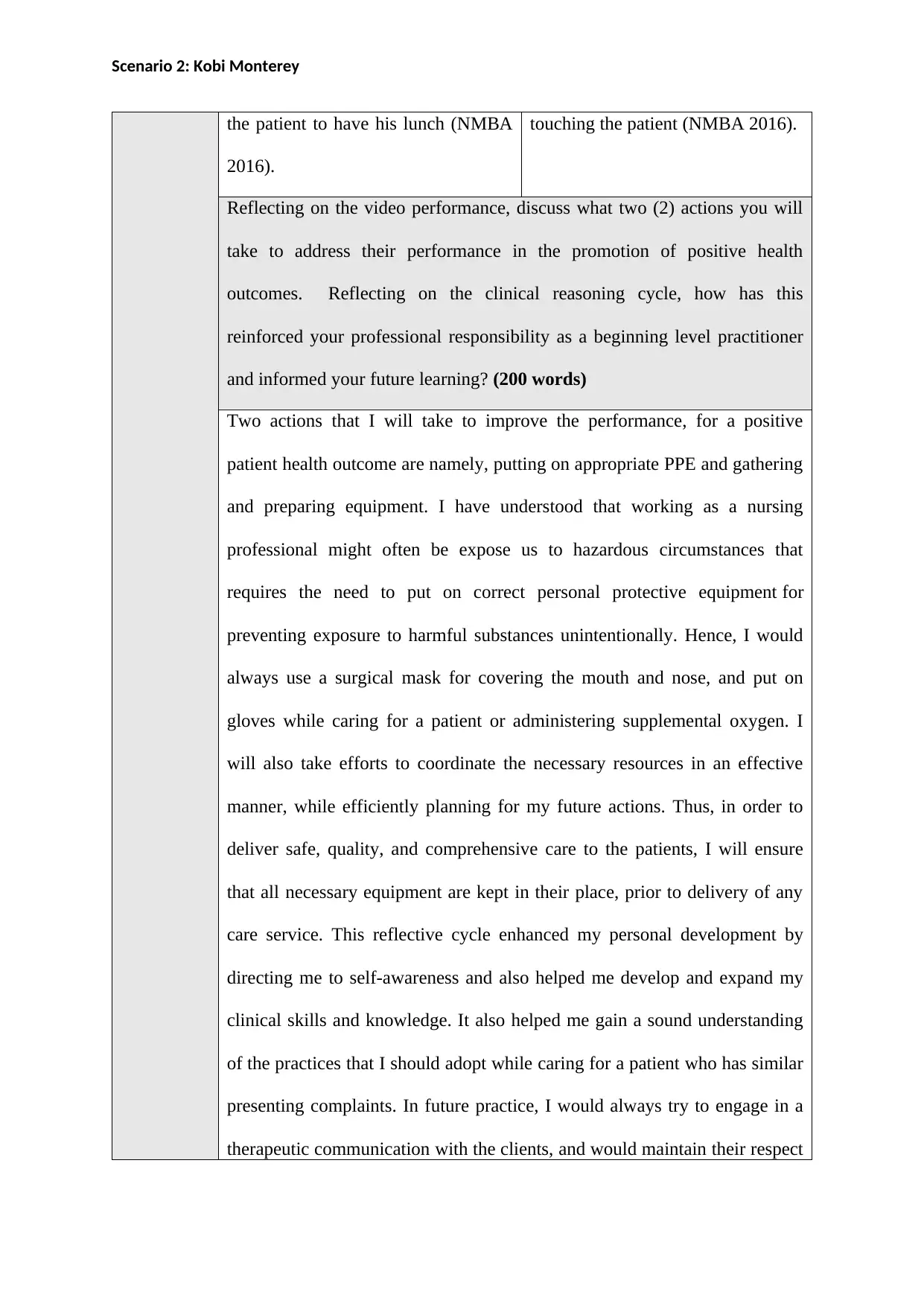
Scenario 2: Kobi Monterey
the patient to have his lunch (NMBA
2016).
touching the patient (NMBA 2016).
Reflecting on the video performance, discuss what two (2) actions you will
take to address their performance in the promotion of positive health
outcomes. Reflecting on the clinical reasoning cycle, how has this
reinforced your professional responsibility as a beginning level practitioner
and informed your future learning? (200 words)
Two actions that I will take to improve the performance, for a positive
patient health outcome are namely, putting on appropriate PPE and gathering
and preparing equipment. I have understood that working as a nursing
professional might often be expose us to hazardous circumstances that
requires the need to put on correct personal protective equipment for
preventing exposure to harmful substances unintentionally. Hence, I would
always use a surgical mask for covering the mouth and nose, and put on
gloves while caring for a patient or administering supplemental oxygen. I
will also take efforts to coordinate the necessary resources in an effective
manner, while efficiently planning for my future actions. Thus, in order to
deliver safe, quality, and comprehensive care to the patients, I will ensure
that all necessary equipment are kept in their place, prior to delivery of any
care service. This reflective cycle enhanced my personal development by
directing me to self-awareness and also helped me develop and expand my
clinical skills and knowledge. It also helped me gain a sound understanding
of the practices that I should adopt while caring for a patient who has similar
presenting complaints. In future practice, I would always try to engage in a
therapeutic communication with the clients, and would maintain their respect
the patient to have his lunch (NMBA
2016).
touching the patient (NMBA 2016).
Reflecting on the video performance, discuss what two (2) actions you will
take to address their performance in the promotion of positive health
outcomes. Reflecting on the clinical reasoning cycle, how has this
reinforced your professional responsibility as a beginning level practitioner
and informed your future learning? (200 words)
Two actions that I will take to improve the performance, for a positive
patient health outcome are namely, putting on appropriate PPE and gathering
and preparing equipment. I have understood that working as a nursing
professional might often be expose us to hazardous circumstances that
requires the need to put on correct personal protective equipment for
preventing exposure to harmful substances unintentionally. Hence, I would
always use a surgical mask for covering the mouth and nose, and put on
gloves while caring for a patient or administering supplemental oxygen. I
will also take efforts to coordinate the necessary resources in an effective
manner, while efficiently planning for my future actions. Thus, in order to
deliver safe, quality, and comprehensive care to the patients, I will ensure
that all necessary equipment are kept in their place, prior to delivery of any
care service. This reflective cycle enhanced my personal development by
directing me to self-awareness and also helped me develop and expand my
clinical skills and knowledge. It also helped me gain a sound understanding
of the practices that I should adopt while caring for a patient who has similar
presenting complaints. In future practice, I would always try to engage in a
therapeutic communication with the clients, and would maintain their respect
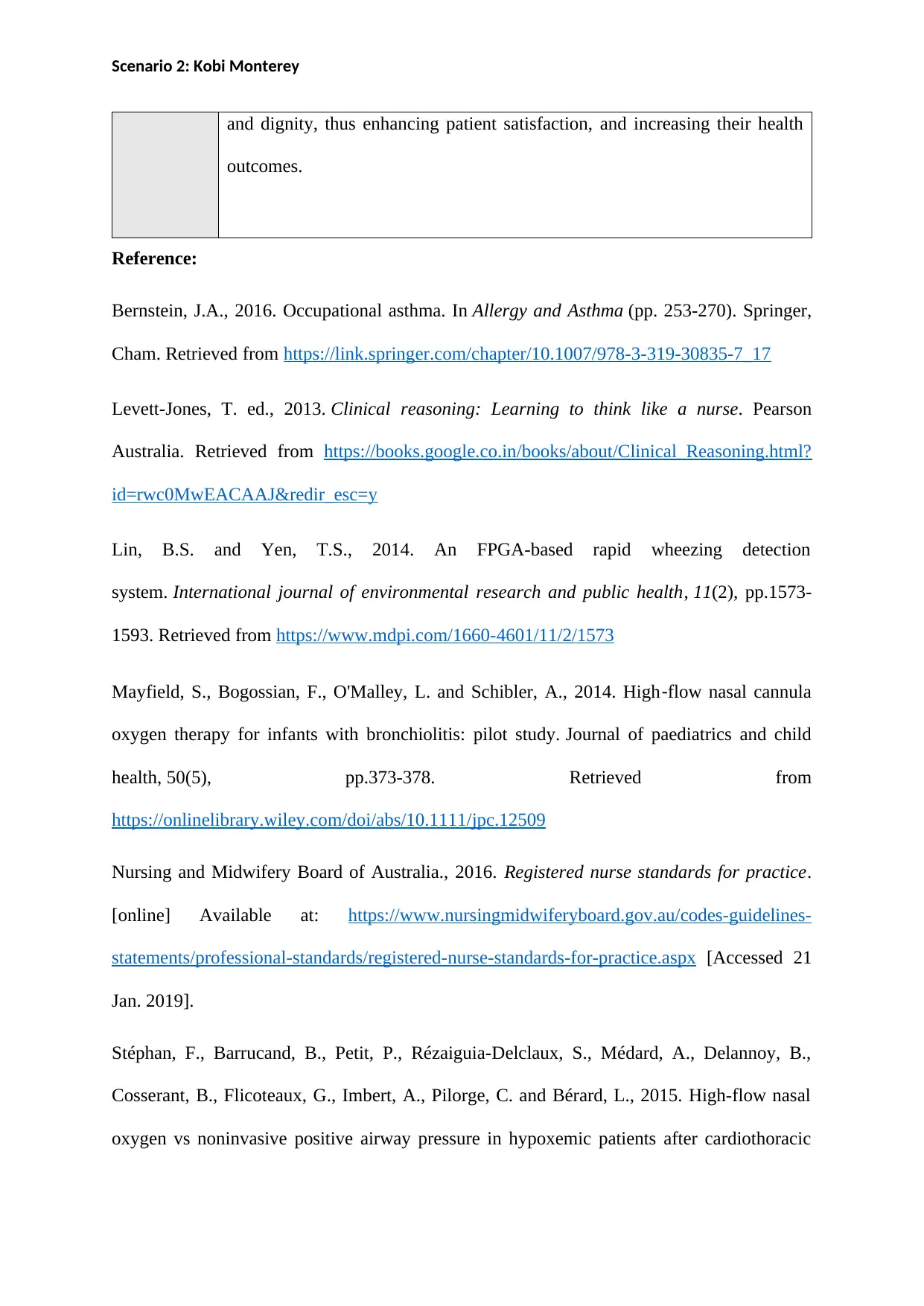
Scenario 2: Kobi Monterey
and dignity, thus enhancing patient satisfaction, and increasing their health
outcomes.
Reference:
Bernstein, J.A., 2016. Occupational asthma. In Allergy and Asthma (pp. 253-270). Springer,
Cham. Retrieved from https://link.springer.com/chapter/10.1007/978-3-319-30835-7_17
Levett-Jones, T. ed., 2013. Clinical reasoning: Learning to think like a nurse. Pearson
Australia. Retrieved from https://books.google.co.in/books/about/Clinical_Reasoning.html?
id=rwc0MwEACAAJ&redir_esc=y
Lin, B.S. and Yen, T.S., 2014. An FPGA-based rapid wheezing detection
system. International journal of environmental research and public health, 11(2), pp.1573-
1593. Retrieved from https://www.mdpi.com/1660-4601/11/2/1573
Mayfield, S., Bogossian, F., O'Malley, L. and Schibler, A., 2014. High‐flow nasal cannula
oxygen therapy for infants with bronchiolitis: pilot study. Journal of paediatrics and child
health, 50(5), pp.373-378. Retrieved from
https://onlinelibrary.wiley.com/doi/abs/10.1111/jpc.12509
Nursing and Midwifery Board of Australia., 2016. Registered nurse standards for practice.
[online] Available at: https://www.nursingmidwiferyboard.gov.au/codes-guidelines-
statements/professional-standards/registered-nurse-standards-for-practice.aspx [Accessed 21
Jan. 2019].
Stéphan, F., Barrucand, B., Petit, P., Rézaiguia-Delclaux, S., Médard, A., Delannoy, B.,
Cosserant, B., Flicoteaux, G., Imbert, A., Pilorge, C. and Bérard, L., 2015. High-flow nasal
oxygen vs noninvasive positive airway pressure in hypoxemic patients after cardiothoracic
and dignity, thus enhancing patient satisfaction, and increasing their health
outcomes.
Reference:
Bernstein, J.A., 2016. Occupational asthma. In Allergy and Asthma (pp. 253-270). Springer,
Cham. Retrieved from https://link.springer.com/chapter/10.1007/978-3-319-30835-7_17
Levett-Jones, T. ed., 2013. Clinical reasoning: Learning to think like a nurse. Pearson
Australia. Retrieved from https://books.google.co.in/books/about/Clinical_Reasoning.html?
id=rwc0MwEACAAJ&redir_esc=y
Lin, B.S. and Yen, T.S., 2014. An FPGA-based rapid wheezing detection
system. International journal of environmental research and public health, 11(2), pp.1573-
1593. Retrieved from https://www.mdpi.com/1660-4601/11/2/1573
Mayfield, S., Bogossian, F., O'Malley, L. and Schibler, A., 2014. High‐flow nasal cannula
oxygen therapy for infants with bronchiolitis: pilot study. Journal of paediatrics and child
health, 50(5), pp.373-378. Retrieved from
https://onlinelibrary.wiley.com/doi/abs/10.1111/jpc.12509
Nursing and Midwifery Board of Australia., 2016. Registered nurse standards for practice.
[online] Available at: https://www.nursingmidwiferyboard.gov.au/codes-guidelines-
statements/professional-standards/registered-nurse-standards-for-practice.aspx [Accessed 21
Jan. 2019].
Stéphan, F., Barrucand, B., Petit, P., Rézaiguia-Delclaux, S., Médard, A., Delannoy, B.,
Cosserant, B., Flicoteaux, G., Imbert, A., Pilorge, C. and Bérard, L., 2015. High-flow nasal
oxygen vs noninvasive positive airway pressure in hypoxemic patients after cardiothoracic
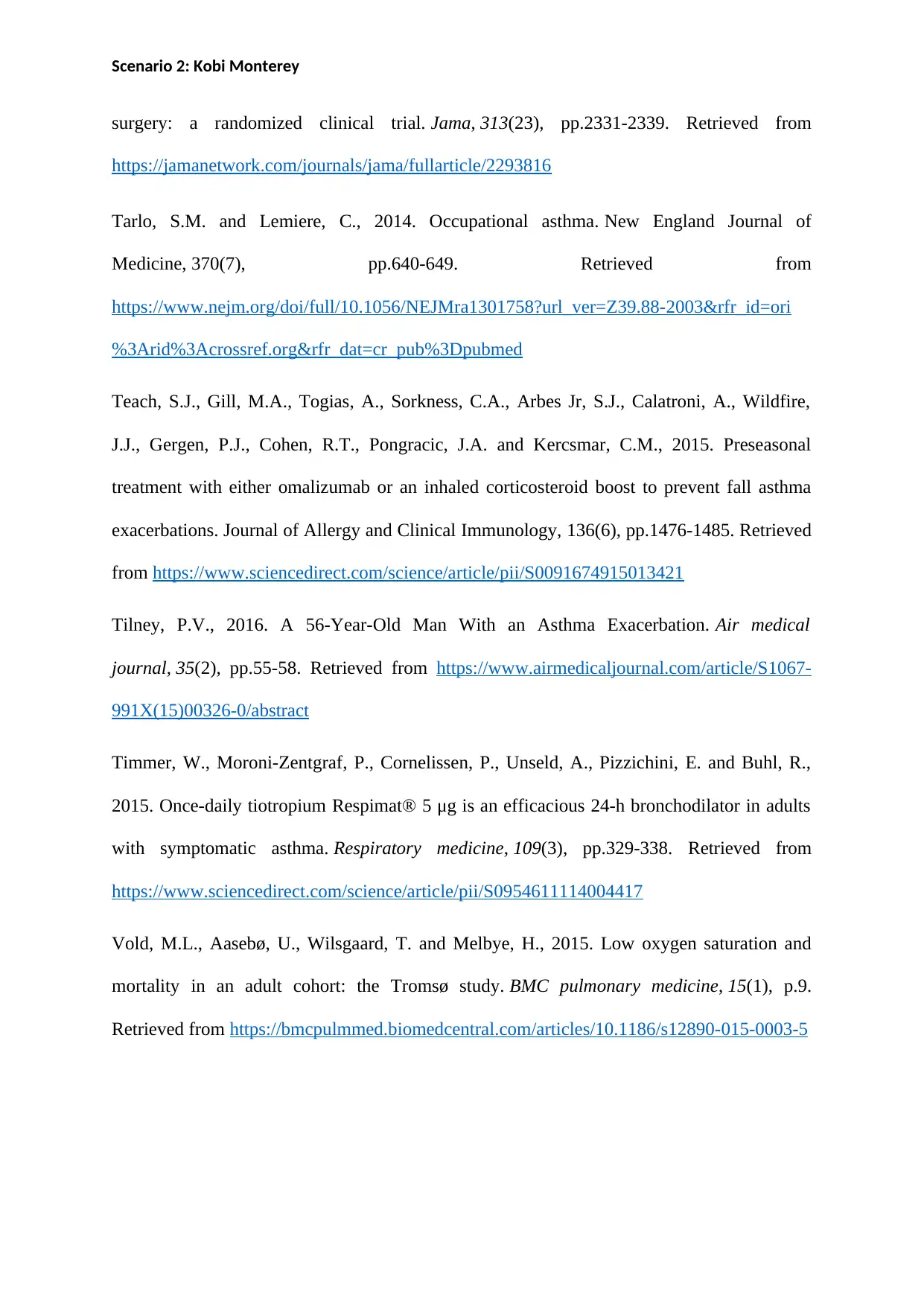
Scenario 2: Kobi Monterey
surgery: a randomized clinical trial. Jama, 313(23), pp.2331-2339. Retrieved from
https://jamanetwork.com/journals/jama/fullarticle/2293816
Tarlo, S.M. and Lemiere, C., 2014. Occupational asthma. New England Journal of
Medicine, 370(7), pp.640-649. Retrieved from
https://www.nejm.org/doi/full/10.1056/NEJMra1301758?url_ver=Z39.88-2003&rfr_id=ori
%3Arid%3Acrossref.org&rfr_dat=cr_pub%3Dpubmed
Teach, S.J., Gill, M.A., Togias, A., Sorkness, C.A., Arbes Jr, S.J., Calatroni, A., Wildfire,
J.J., Gergen, P.J., Cohen, R.T., Pongracic, J.A. and Kercsmar, C.M., 2015. Preseasonal
treatment with either omalizumab or an inhaled corticosteroid boost to prevent fall asthma
exacerbations. Journal of Allergy and Clinical Immunology, 136(6), pp.1476-1485. Retrieved
from https://www.sciencedirect.com/science/article/pii/S0091674915013421
Tilney, P.V., 2016. A 56-Year-Old Man With an Asthma Exacerbation. Air medical
journal, 35(2), pp.55-58. Retrieved from https://www.airmedicaljournal.com/article/S1067-
991X(15)00326-0/abstract
Timmer, W., Moroni-Zentgraf, P., Cornelissen, P., Unseld, A., Pizzichini, E. and Buhl, R.,
2015. Once-daily tiotropium Respimat® 5 μg is an efficacious 24-h bronchodilator in adults
with symptomatic asthma. Respiratory medicine, 109(3), pp.329-338. Retrieved from
https://www.sciencedirect.com/science/article/pii/S0954611114004417
Vold, M.L., Aasebø, U., Wilsgaard, T. and Melbye, H., 2015. Low oxygen saturation and
mortality in an adult cohort: the Tromsø study. BMC pulmonary medicine, 15(1), p.9.
Retrieved from https://bmcpulmmed.biomedcentral.com/articles/10.1186/s12890-015-0003-5
surgery: a randomized clinical trial. Jama, 313(23), pp.2331-2339. Retrieved from
https://jamanetwork.com/journals/jama/fullarticle/2293816
Tarlo, S.M. and Lemiere, C., 2014. Occupational asthma. New England Journal of
Medicine, 370(7), pp.640-649. Retrieved from
https://www.nejm.org/doi/full/10.1056/NEJMra1301758?url_ver=Z39.88-2003&rfr_id=ori
%3Arid%3Acrossref.org&rfr_dat=cr_pub%3Dpubmed
Teach, S.J., Gill, M.A., Togias, A., Sorkness, C.A., Arbes Jr, S.J., Calatroni, A., Wildfire,
J.J., Gergen, P.J., Cohen, R.T., Pongracic, J.A. and Kercsmar, C.M., 2015. Preseasonal
treatment with either omalizumab or an inhaled corticosteroid boost to prevent fall asthma
exacerbations. Journal of Allergy and Clinical Immunology, 136(6), pp.1476-1485. Retrieved
from https://www.sciencedirect.com/science/article/pii/S0091674915013421
Tilney, P.V., 2016. A 56-Year-Old Man With an Asthma Exacerbation. Air medical
journal, 35(2), pp.55-58. Retrieved from https://www.airmedicaljournal.com/article/S1067-
991X(15)00326-0/abstract
Timmer, W., Moroni-Zentgraf, P., Cornelissen, P., Unseld, A., Pizzichini, E. and Buhl, R.,
2015. Once-daily tiotropium Respimat® 5 μg is an efficacious 24-h bronchodilator in adults
with symptomatic asthma. Respiratory medicine, 109(3), pp.329-338. Retrieved from
https://www.sciencedirect.com/science/article/pii/S0954611114004417
Vold, M.L., Aasebø, U., Wilsgaard, T. and Melbye, H., 2015. Low oxygen saturation and
mortality in an adult cohort: the Tromsø study. BMC pulmonary medicine, 15(1), p.9.
Retrieved from https://bmcpulmmed.biomedcentral.com/articles/10.1186/s12890-015-0003-5
1 out of 13
Related Documents
Your All-in-One AI-Powered Toolkit for Academic Success.
+13062052269
info@desklib.com
Available 24*7 on WhatsApp / Email
![[object Object]](/_next/static/media/star-bottom.7253800d.svg)
Unlock your academic potential
© 2024 | Zucol Services PVT LTD | All rights reserved.





